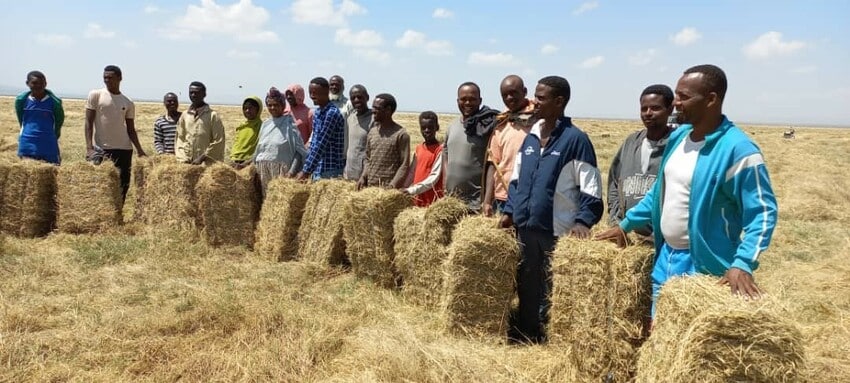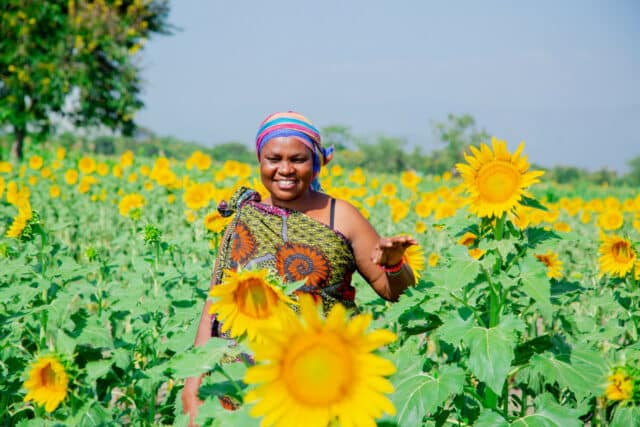Expert view
Ethiopia
13 November 2024
Why nature wins when climate finance reaches small-scale farmers

Benjamin, a village-based advisor in Farm Africa's regenerative agriculture project, and his wife Rose, inspect their farm in Tharaka Nithi, Kenya.
By Dan Collison, Chief Executive
As world leaders gather in the Azerbaijani capital of Baku to attend COP29, the 29th UN Climate Change Conference, the stakes have never been higher. Headlines reveal that 2024 is on track to be the hottest year on record.
As he addressed the conference on Tuesday, UN secretary general António Guterres described the year as “2024 – a masterclass in climate destruction”.
That’s a sentiment sure to be shared by the world’s small-scale farmers, who face escalating challenges to making a living in the face of ever more frequent and severe cycles of drought and flooding.
Climate extremes in eastern Africa
In eastern Africa, smallholder farmers are reeling from the impact of living through five consecutive poor rainy seasons – the region’s longest drought in recent history – which have left more than 32 million people facing high levels of acute food insecurity in Ethiopia, Kenya and Somalia and 9.5 million livestock dead.

As drought took hold in Ethiopia, pastoralists moved from their home to other areas, where water and animal fodder were available.
This drought was bookended by devastating floods across the region in 2020 and 2024, which washed away infrastructure and productive land.
Small-scale farmers’ yields, incomes and food security are all at risk as rising temperatures, unpredictable rainfall and water stress threaten crop and livestock health and increase the incidence of pests and disease.
Lack of finance to adapt
Small-scale farmers typically lack access to the finance needed to invest in climate adaptation or to provide a buffer when climate shocks strike.
Despite producing up to 70% of the food produced in low- and middle-income countries, small-scale farmers currently receive just 0.8 per cent of global climate finance each year, totalling US$5.53 billion.
IFAD estimates this is just one fourteenth of the $75 billion needed globally.
It’s clear there is urgent need to increase the climate finance reaching small-scale farmers.
An investment in nature
The urgency stems not just from the need to protect food security and livelihoods, but from the need to protect nature and biodiversity.
Small-scale farmers are the custodians of large swathes of our landscapes worldwide. When their businesses dwindle, so too do the ecosystems they manage.
Faced with falling yields, many farmers have no choice but to encroach into forests. Agriculture accounts for 70-80% of tropical deforestation, a major driver of climate change.
However, it is increasingly clear that the most effective way for small-scale farmers to adapt, rebuild and grow stronger in the face of climate change is to implement nature-based solutions that reduce carbon emissions as well as increase agricultural productivity.
Increasing the flows of climate finance to small-scale farmers offers the opportunity for them to invest in approaches such as regenerative agriculture, which uses organic matter to rebuild soil health and stores more carbon in soils; and agroforestry, which boosts crop yields by planting trees alongside crops.

Farmers in Ethiopia protecting their hot pepper crops with mulch.
These nature-based approaches enable farmers not just to adapt to climate change so they can increase their food security and incomes. They also reduce carbon emissions, and benefit nature by protecting biodiversity.
Strength in numbers
Key to untapping the benefits of nature-based solutions is working together in groups. The average size of land that small-scale farmers manage is typically less than two hectares. On their own, it’s hard for these farmers to capture the interest of major market players.
When united and working together in groups, small-scale farmers become a force to be reckoned with.
Farm Africa can point to numerous examples across eastern Africa of how working in groups unlocks small-scale farmers’ ability to build climate-resilient businesses that benefit both food security and nature.
In Kenya, Farm Africa and AGRA are promoting regenerative agriculture approaches to 60,000 farmers via Village-Based Advisors who not only offer agronomic advice but provide farmers with a route to market via aggregation services.
Via the ACORN initiative we are supporting 20,000 of those farmers to also engage with carbon markets to monetise the carbon sequestered by the trees.

A participatory rangeland management co-operative at Desta Abijata in Ethiopia has restored productivity of grasslands, which had been degraded for many years.
In Ethiopia, we’re supporting farmers to form cooperatives who develop thriving local businesses rooted in the sustainable management of rangelands and forests.
In Tanzania, we’re working with farmers to develop networks that help farmers easily access high-quality seeds, which are more tolerant of drier conditions.

Elizabeth, a farmer in Tanzania, cleans and sorts quality declared sorghum seeds.
These initiatives support small-scale farmers to not just survive climate change, but actually profit from becoming more resilient.
Many more of these initiatives would be possible if climate finance for small-scale farmers were increased. The impact would be seen not just in food security and farmers’ incomes, but in the preservation of biodiversity, some of which if lost, can never be returned.




